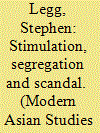|
|
|
Sort Order |
|
|
|
Items / Page
|
|
|
|
|
|
|
| Srl | Item |
| 1 |
ID:
178812


|
|
|
|
|
| Summary/Abstract |
The UK government's policy of support for shale gas extraction ended in November 2019 with the imposition of a moratorium on fracking (hydraulic fracturing) in England, and an admission that the policies to manage induced seismicity were insufficient. However, ambiguities remain regarding its scope, despite attempts at clarification. The concept of fracking to improve hydrocarbon production has evolved from defining a specific engineering process, using high volumes of water, to encompass other ‘unconventional’ methods to achieve the same end. We resolve the various definitions in a scientific, technical, regulatory and legislative context, robustly define unconventional extraction methods (circumventing the need to identify and quantify the various technologies available), and advocate the precautionary principle in drafting and interpreting regulations. Policy should be driven by the engineering of the bulk physical characteristics of the target rock, rather than by the current definitions based on injected fluid volume. To meet climate change concerns, the moratorium should be converted into a ban. In the interim, we argue that, in order to comply with the government's policy of ensuring safe and sustainable operations, the moratorium should be extended to all well stimulation treatments for unconventional hydrocarbon extraction, including acid stimulation.
|
|
|
|
|
|
|
|
|
|
|
|
|
|
|
|
| 2 |
ID:
137660


|
|
|
|
|
| Summary/Abstract |
As the gateway to human communication, the sense of hearing is of enormous importance in our lives. Research on hearing has recently been revolutionized by the demonstration that the ear is not simply a passive receiver for sound, but also an amplifier that augments, filters, and compresses its inputs. Hair cells, the ear's sensory receptors, use two distinct methods to implement an active process that endows our hearing with these remarkable properties. First, the vibration-sensitive structures of the ear, called hair bundles, display a mechanical instability that allows them to oscillate in response to stimulation. And second, the membranes of hair cells are replete with proteins that contract in response to electrical stimuli, thus enabling the cells to act like tiny muscles. The activity of these two motile processes can be so exuberant as to cause normal ears to emit sounds.
|
|
|
|
|
|
|
|
|
|
|
|
|
|
|
|
| 3 |
ID:
115284


|
|
|
|
|
| Publication |
2012.
|
| Summary/Abstract |
This paper explores the regulation of prostitution in colonial India between the abolition of the Indian Contagious Diseases Act in 1888 and the passing of the first Suppression of Immoral Traffic Act in 1923. It challenges the commonly held assumption that prostitutes naturally segregated themselves in Indian cities, and shows that this was a policy advocated by the Government of India. The object was to prevent the military visiting these segregated areas, in the absence of effective Cantonment Regulations for registering, inspecting, and treating prostitutes. The central government stimulated provincial segregation through expressing its desires via demi-official memoranda and confidential correspondence, to which Rangoon and Bombay responded most willingly. The second half of the paper explores the conditions, in both India and Ceylon, that made these segregated areas into scandalous sites in the early twentieth century. It situates the brothel amongst changing beliefs that they: increased rather than decreased incidents of homosexuality; stimulated trafficking in women and children; and encouraged the spread of scandalous white prostitutes 'up-country', beyond their tolerated location in coastal cosmopolitan ports. Taken alongside demands that the state support social reform in the early twentieth century, segregation provided the tipping point for the shift towards suppression from 1917 onwards. It also illustrates the scalar shifts in which central-local relations, and relations between provinces, in government were being negotiated in advance of the dyarchy system formalized in 1919.
|
|
|
|
|
|
|
|
|
|
|
|
|
|
|
|
| 4 |
ID:
147797


|
|
|
|
|
| Summary/Abstract |
The authors review different types of planning as a control function. They provide an essential analysis of strategic and budgetary strategic planning, directed toward creating an integrated target program for the financial activity of enterprises, including those of the defense-industrial complex.
|
|
|
|
|
|
|
|
|
|
|
|
|
|
|
|
|
|
|
|
|